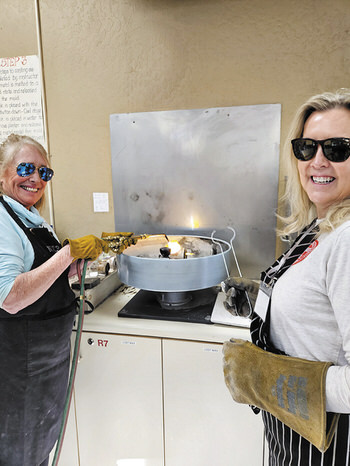
Anita Metzbower and Lisa Sherburne pouring silver jewelry (photo by Sarah Marks)
Sarah Marks
Lost wax casting is a time-honored technique in jewelry making that allows artisans to create intricate designs from their own imagination. This innovative process not only gives birth to stunning pieces of jewelry but also connects contemporary artisans with a rich, historical tradition dating back 6,000 years to ancient Egypt. This essay explores the lost wax casting technique, its historical significance, modern adaptations, and the contemporary applications in jewelry design.
The lost wax technique begins with creating a wax model of the desired design. This model is then encased in a plaster cast. During the kiln firing, the wax melts away—hence, the name “lost wax”—leaving behind a cavity that mirrors the original design. Once the wax has been eliminated, the plaster shell is ready to receive molten metal, which is introduced through a centrifuge that ensures the metal fills the design completely. Within minutes, a new piece of jewelry is born, showcasing the creativity of the artist.
The origins of lost wax casting date back to ancient Egypt where sculptors and artisans crafted tools and votive idols using beeswax models and clay molds. This technique was pivotal in the creation of iconic works by renowned artists such as Donatello, Michelangelo, and Auguste Rodin whose famous bronze sculptures were realized through this method. The historical significance of lost wax casting lies in its ability to create enduring art that reflects both the skill of the artist and the cultural context of the time.
In modern times, jewelry designers continue to push the boundaries of creative expression via the lost wax technique. Artists such as Elsa Peretti and Paloma Picasso have made significant contributions to the field, producing recognizable shapes and styles for Tiffany & Co. As gold prices have soared, many contemporary designers have turned to alternative materials like silver, rose bronze, and yellow bronze. Moreover, the combination of different metals in stackable rings and bracelets offers customers unique and customizable options, showcasing individuality and style.
A noteworthy aspect of the lost wax casting process is the incorporation of gemstones. Depending on the stone’s heat tolerance, gemstones can be embedded either before or after the firing process. This flexibility allows artisans to create breathtaking pieces that integrate both metal and gems harmoniously, resulting in jewelry that is both visually striking and artistically unique.
The lost wax casting technique serves as a bridge between historical craftsmanship and modern artistic expression. By understanding and utilizing this ancient method, contemporary jewelry designers are able to create novel pieces that honor tradition while embracing innovation. As the field continues to evolve, lost wax casting remains a testament to the power of human creativity and the enduring beauty of handcrafted jewelry.
If you’re looking to explore your creative side and learn a new skill, the lost wax is taught in both the Oakwood and Cottonwood Silver Shops. For more information, please contact slrgsconnect@gmail.com or visit the Sun Lakes Rock, Gem & Silver Club website at www.slrgs.com for more details.
